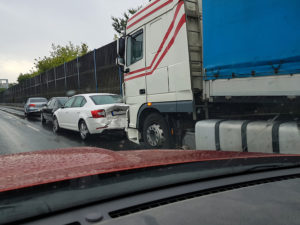 A 57-year-old woman was killed after a tractor-trailer rear-ended the vehicle in which she was riding in a work zone on Route 222. The accident occurred when the truck driver, a 53-year-old Florida man, failed to brake or slow down upon entering the work zone. After striking the woman’s car—which sustained serious damage, the tractor-trailer went on to hit two other vehicles. Police suspected at the time that speeding was a factor. All of the occupants of the vehicles were transported to area hospitals, and the woman died of her injuries at Lancaster General.
A 57-year-old woman was killed after a tractor-trailer rear-ended the vehicle in which she was riding in a work zone on Route 222. The accident occurred when the truck driver, a 53-year-old Florida man, failed to brake or slow down upon entering the work zone. After striking the woman’s car—which sustained serious damage, the tractor-trailer went on to hit two other vehicles. Police suspected at the time that speeding was a factor. All of the occupants of the vehicles were transported to area hospitals, and the woman died of her injuries at Lancaster General.
In Pennsylvania, more than 28,000 rear-end accidents took place in one recent year, making it one of the most common types of accidents in the state. Those accidents resulted in 81 fatalities. In the same year, there were 155 fatalities in heavy truck-related accidents. Truck accidents are particularly deadly, and rear-end accidents are common. The combination of the two can result in a lifetime of serious injuries or even death. If you’ve been injured in a rear-end truck accident, you may be eligible for compensation. An experienced truck accident attorney can provide answers to your legal questions.
What Causes a Rear-End Truck Accident?
Rear-end collisions involving tractor-trailers can occur due to:
- Following too closely: Weighing 20 to 30 times more than a passenger vehicle, a commercial truck requires more space in which to come to a safe stop. A truck that is following another vehicle too closely in traffic runs the risk of causing a deadly accident due to not having enough space to stop safely.
- Speeding: Speeding not only reduces the time that a vehicle has to stop—which, in the case of a tractor-trailer, is already reduced due to the vehicle’s size—but it also makes the vehicle harder to control.
- Vehicles in the truck’s blind spot: Tractor-trailers have significant blind spots on all four sides. Passenger vehicles that travel in or changes lanes into the truck’s front blind spot are in danger of being involved in a rear-end accident due to the truck driver being unable to see them and to accurately judge how fast they’re going.
- Distracted driving: Very few people realize how distracted they are with common activities while driving, such as texting, talking on the phone, browsing the internet, eating or drinking, adjusting the controls on the GPS and other equipment, and more. Texting, in particular, is a deadly distraction. As reported by the Federal Motor Carrier Safety Administration, it takes approximately 4.6 seconds for a driver to read or respond to a text. This means that the eyes are off the roadway, the focus is off the task of driving, and the hands are not properly positioned on the wheel during this time. A driver traveling at 55 miles per hour can travel about the length of a football field in that time, without being fully aware of slowing traffic or other hazards up ahead.
- Defective or poorly maintained brakes: At up to 80,000 pounds, a semi-truck relies heavily on its brakes to travel safely. If those brakes are unsafe to begin with due to being improperly designed, or if the driver or trucking company does not regularly maintain them, the brakes can go out and spell disaster for anyone in the truck’s path.
- Drowsy driving: In spite of hours of service regulations that determine how many hours a truck driver can be behind the wheel before he or she must take an off-duty break, many drivers violate this rule and drive while fatigued. Additionally, the Federal Motor Carrier Safety Administration reports that almost one-third of commercial truck drivers suffer from sleep apnea, which is a breathing-related sleep disorder that causes numerous brief interruptions during sleep and leaves the sufferer feeling drowsy even after getting a full night’s sleep. Fatigue produces many of the same effects on the driving skills needed to operate a vehicle safely as alcohol impairment does. Some of the functions impacted include the driver’s ability to focus on a task, to travel at a safe and legal speed, and to react within a timely manner to hazards on the roadway.
- Alcohol impairment: As noted above, alcohol impairment causes deficits in a driver’s ability to safely operate a motor vehicle, including concentration and reaction times.
- Work zones: Work zones often cause stop and start traffic, sudden changes in speed, as well as confusing road alignments. As previously noted, large trucks have difficulty with short-distance stopping. That, in addition to confusion by the truck driver or other drivers in the work zone, is a major cause of rear-end truck accidents.
- Multi-car pileups: Because it takes so much time and space for a truck to come to a stop, a rear-end accident involving a commercial truck is also a risk in a situation in which there is a previous accident on the roadway and the truck driver does not realize until there is neither enough time nor space. In multi-car pileups, it is often difficult to sort out exactly who is liable.
Compensation After Being Rear-Ended by a Commercial Truck
According to the Insurance Institute of Highway Safety, most fatalities in accidents involving commercial trucks are the occupants of passenger cars. In 2017, 68 percent of the 4,102 deaths from truck accidents were those traveling in passenger cars, while 17 percent were the occupants of the trucks, and another 14 percent were pedestrians, bicyclists, and motorcyclists. In two-vehicle fatal accidents involving a large truck and a passenger vehicle, 97 percent of the fatalities were the occupants of the passenger vehicle.
Truck accident injuries are almost always serious. If you were rear-ended by a tractor-trailer, you are likely facing a lot of expenses. How does one receive compensation for accidents such as these?

Generally, the process begins with filing a personal injury claim with the insurance providers for all liable parties. There may be more than one liable party, particularly in an accident involving a commercial truck. Some examples of individuals or entities who may have been responsible for the accident include:
- The truck driver
- The company that employs the driver
- The company whose goods were being transported
- The individual or company responsible for performing maintenance on the truck
- The manufacturer or distributor of faulty truck parts
- Other drivers whose actions may have led to the accident
To establish that someone is liable for an accident, you must prove negligence. Negligence is established by satisfying these three facts:
- The at-fault party owed a duty of care to the victim. For example, in the case of proving that a truck driver was responsible for a rear-end truck accident, the duty of care would have been to operate the vehicle in a safe and lawful manner and to obey all regulations set forth by the Federal Motor Carrier Safety Administration.
- There was a breach in the duty of care that was owed. The breach would be the negligent behavior that caused the accident, such as a speeding truck driver or a manufacturer who designed faulty brakes.
- This breach resulted in the accident that caused the victim’s injuries.
Often, insurance companies who cover trucking companies and truck drivers will dispute the claims brought against their insured and attempt to place liability on other parties, including the victim. While preparing and making your claim, seeking the assistance of a personal injury attorney who has experience in this type of case is important, as the attorney may provide these services during the process:
- Determining all liable parties and sources of insurance to obtain the best settlement available to you in your case.
- Establishing a value for your case that takes into consideration not only the expenses you’ve already faced due to your injuries, but also the expenses you will face in the future, including how your injuries will impact your future earning capacity, what sort of medical and adaptive assistance you will need through the duration of your injury, how your injuries have impacted your personal life and your relationship with your loved ones, and any permanent disabilities that you may have as a result of your injuries.
- Negotiating with the insurance providers in pursuit of a fair settlement.
- Securing the collection of compensation in accordance with the settlement terms.
- Legal guidance as to the options that are available to you should the insurance company in your case not offer a fair settlement.
If a settlement is not offered or agreed upon, you may have the option under Pennsylvania law to file a personal injury lawsuit against all liable parties in your case. Some of the highlights of this aspect of the law include:
- Statute of limitation: Generally, those who have been injured in an accident have two years after the date of the accident to file a suit. Claims against a governmental agency must be made within six months. Your attorney can advise you as to the process of filing a personal injury claim against a governmental agency.
- Multiple parties that share liability: Oftentimes, a car accident is the fault of multiple involved parties. Even if you are partially responsible for your accident, you can still seek compensation for your injuries. If you believe that you may face liability for your accident, or if you believe that multiple parties caused your accident and want to seek compensation from all of them, you should enlist the services of an experienced car accident attorney.
The state’s constitution specifically prohibits any limitation on damages in cases that involve injury or death.
Frequently Asked Questions About Rear-End Truck Accident Cases
Have questions about the legal process of obtaining compensation after a rear-end truck accident? An experienced personal injury attorney is a great resource for answers to those questions.
If your vehicle gets rear-ended by a truck, is it always the truck driver’s fault?
Not always. As described above, there can be other liable parties, including the manufacturer of the truck’s brakes or the individual or company who was responsible for maintaining the truck. Additionally, there are cases in which liability falls on the individual in the lead car, such as if he or she was driving with defective brake lights and the truck driver was unable to tell that he or she was slowing or stopping, or if he or she failed to yield the right-of-way to the truck.
How can truck drivers with sleep apnea continue to drive?
Some drivers are unaware that they have the condition. Others know that they have sleep apnea but are unaware that the effects are so severe that they pose a safety risk.
My loved one died due to a rear-end truck accident. Is there compensation available to deal with the expenses caused by his death?
Yes, you should speak with an attorney regarding your eligibility to file a wrongful death lawsuit or a survival claim. Some of the damages that you’re allowed to claim through these actions include the costs of funeral and burial expenses, the decedent’s final medical expenses, the loss of financial contributions from the decedent to the family, and the loss of moral support and guidance that the decedent would have provided had he or she lived. An experienced truck accident attorney can assist you with these claims.
If I hire a personal injury attorney to help me with a claim against the truck driver in my case, does that mean my case will go to trial?
Not necessarily. In fact, the majority of personal injury claims are settled before they reach the courtroom. However, the truck accident attorney you hire should be comfortable and confident in representing you in litigation should it prove necessary to take your case to trial.
Injured in a truck accident in Pennsylvania? A truck accident lawyer can help you understand the options available to you.
